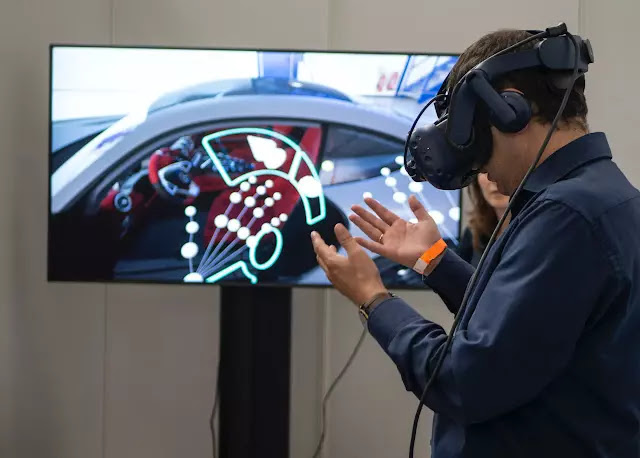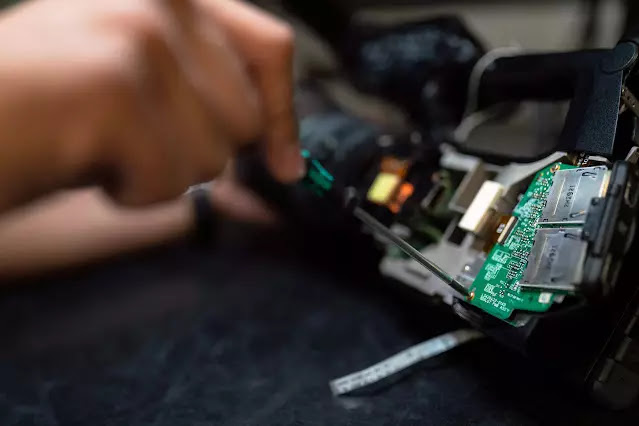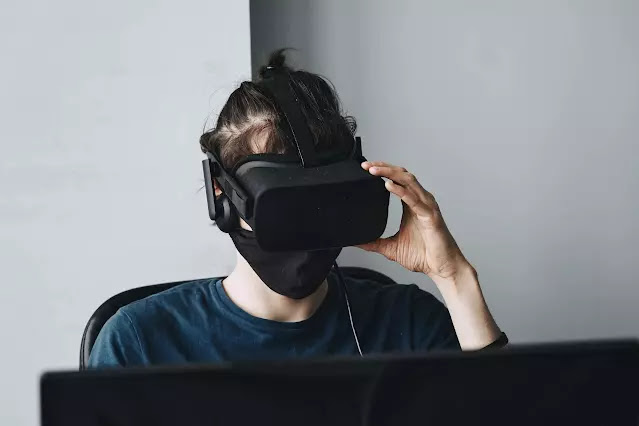What will the future of virtual and augmented reality
look like?
Virtual and augmented reality is rapidly changing the way we interact with technology. These cutting-edge technologies are allowing us to experience new worlds, and explore new possibilities in ways that were once unimaginable. In this article, we will explore some of the boundless possibilities of virtual and augmented reality and how it is being used in different fields and industries.
Virtual Reality:
- Gaming:
One of the most popular applications of VR technology is in gaming. With VR, players can immerse themselves in a fully-realized game world, and interact with it in a way that was previously impossible. VR gaming is becoming increasingly popular, and it is likely that it will continue to grow in the future.- Education:
VR technology is also being used in education to provide students with a more engaging and interactive learning experience. With VR, students can take virtual field trips, explore historical sites, and even interact with virtual simulations of scientific concepts.- Healthcare:
VR technology is also being used in healthcare to help patients with a variety of conditions. For example, VR can be used to help patients with chronic pain, anxiety, and PTSD.Augmented Reality:
- Gaming:
AR technology is being used in gaming to provide players with a more immersive gaming experience. For example, players can use AR technology to see virtual characters in the real world.- Education:
AR technology is also being used in education to provide students with a more engaging and interactive learning experience. For example, students can use AR technology to view virtual models of scientific concepts and explore historical sites in a more interactive way.- Healthcare:
AR technology is also being used in healthcare to help patients with a variety of conditions. For example, AR can be used to help patients with chronic pain, anxiety, and PTSD.2- A Peek into the Virtual and Augmented Reality
Landscape of Tomorrow
- Advancements in Hardware:
- Increase in the Use of VR and AR in Education:
- Advancements in Healthcare:
- Increase in Use of VR and AR in Business and Industry:
3- Transforming Reality: How Virtual and Augmented
Reality will Shape the Future
- Gaming:
Virtual reality (VR) technology is already being used in the gaming industry to provide players with a more immersive gaming experience. With VR, players can immerse themselves in a fully-realized game world and interact with it in a way that was previously impossible. As VR technology continues to advance, it is likely that we will see even more realistic and immersive gaming experiences in the future.- Education:
VR technology is also being used in education to provide students with a more engaging and interactive learning experience. With VR, students can take virtual field trips, explore historical sites, and even interact with virtual simulations of scientific concepts. As VR technology continues to advance, it is likely that we will see even more innovative and interactive educational experiences in the future.- Healthcare:
VR technology is also being used in healthcare to help patients with a variety of conditions. For example, VR can be used to help patients with chronic pain, anxiety, and PTSD. As VR technology continues to advance, it is likely that we will see even more innovative and effective uses of VR in healthcare in the future.
4- The Next Frontier: How Virtual and Augmented
Reality is Changing the Game
- Gaming:
In the gaming industry, virtual reality (VR) technology is already being used to provide players with a more immersive gaming experience. With VR, players can immerse themselves in a fully realized game world and interact with it in previously unimaginable ways. As VR technology advances, we can expect to see even more realistic and immersive gaming experiences in the future.
- Education:
VR technology is also being used in education to make learning more engaging and interactive for students. Students can use virtual reality to go on virtual field trips, explore historical sites, and even interact with virtual simulations of scientific concepts. As VR technology advances, we can expect to see even more innovative and interactive educational experiences in the future.
- Healthcare:
VR technology is also being used in healthcare to assist patients suffering from a variety of ailments. VR, for example, can be used to help patients suffering from chronic pain, anxiety, and PTSD. As VR technology advances, we can expect to see even more innovative and effective uses of VR in healthcare in the future.
5- Imagining the Future: How Virtual and Augmented
Reality will Impact Our Lives
- Entertainment:
One of the most obvious ways in which VR and AR will impact our lives is in the entertainment industry. These technologies will allow us to experience movies, TV shows, and games in a more immersive way. For example, with VR, we will be able to immerse ourselves in a fully-realized game world and interact with it in ways that were once impossible. With AR, we will be able to see virtual characters in the real world.
- Education:
Another way in which VR and AR will impact our lives is in education. These technologies will allow students to take virtual field trips, explore historical sites, and interact with virtual simulations of scientific concepts. This will make education more engaging and interactive for students.
- Healthcare:
VR and AR will also have a significant impact on healthcare. These technologies will be used to help patients with a variety of conditions, such as chronic pain, anxiety, and PTSD. For example, VR can be used to provide patients with a more immersive experience during physical therapy and AR can be used to help patients with visual impairments to navigate their surroundings.
6- Beyond Gaming: The Real-World Applications of
Virtual and Augmented Reality
- Architecture and Design:
VR and AR technologies are being used in architecture and design to create virtual models of buildings and other structures. This allows architects and designers to visualize their designs in a more realistic way and make changes before construction begins.
- Retail:
VR and AR technologies are also being used in retail to create virtual showrooms and try-on experiences. This allows customers to see how a product will look in their homes or on their body before making a purchase.
- Training:
VR and AR technologies are also being used in training, particularly in fields such as aviation, medicine, and the military. These technologies allow trainees to experience realistic simulations of dangerous or difficult situations without the risk of injury.
7- The Rise of Virtual and Augmented Reality:
Opportunities and Challenges Ahead
Opportunities:
- Enhanced Gaming Experience: Virtual reality (VR) technology is being used in gaming to provide players with a more immersive gaming experience. With VR, players can immerse themselves in fully-realized game worlds and interact with them in ways that were once impossible.
- Improved Education: Virtual reality technology is also being used in education to provide students with a more engaging and interactive learning experience. With VR, students can take virtual field trips and explore historical sites, and even interact with virtual simulations of scientific concepts.
- Advancements in Healthcare: Virtual reality technology is also being used in healthcare to help patients with a variety of conditions. For example, VR can be used to help patients with chronic pain, anxiety, and PTSD.
- Increased Productivity: Augmented reality (AR) technology is being used in a variety of industries to increase productivity. For example, in manufacturing, AR technology can be used to provide workers with real-time information about the products they are working on.
- New Ways of Communication: AR technology is also being used in communication to provide users with new ways to interact with each other. For example, AR technology can be used to provide users with real-time translations of spoken languages.
Challenges:
- High Costs: Virtual and augmented reality technology is still relatively new, and the cost of the equipment required to use it can be high. This can make it difficult for some people to access and use the technology.
- Lack of Standardization: Virtual and augmented reality technology is still in the early stages of development, and there is no standardization of the technology. This can make it difficult for developers to create applications that are compatible with all VR and AR devices.
- Privacy and Security: Virtual and augmented reality technology can also raise privacy and security concerns. For example, virtual reality technology can be used to collect personal data without the user's knowledge.
- Health Concerns: Virtual and augmented reality technology can also raise health concerns. For example, prolonged use of VR technology can cause eye strain, headaches, and other health problems.
8- From Fantasy to Reality: How Virtual and
Augmented Reality is Changing Industries
- Entertainment Industry:
The entertainment industry has been one of the first to embrace VR and AR technologies. The gaming industry, in particular, has been quick to adopt these technologies to provide players with a more immersive gaming experience. With VR, players can immerse themselves in a fully-realized game world, and interact with it in a way that was previously impossible. AR technology is also being used in gaming to provide players with a more immersive gaming experience. For example, players can use AR technology to see virtual characters in the real world.
- Education and Training Industry:
VR and AR technologies are also being used in the education and training industry to provide students and trainees with a more engaging and interactive learning experience. With VR, students can take virtual field trips, explore historical sites, and even interact with virtual simulations of scientific concepts. AR technology is also being used in education to provide students with a more engaging and interactive learning experience. For example, students can use AR technology to view virtual models of scientific concepts and explore historical sites in a more interactive way.
- Healthcare Industry:
VR and AR technologies are also being used in the healthcare industry to help patients with a variety of conditions. For example, VR can be used to help patients with chronic pain, anxiety, and PTSD. AR technology is also being used in healthcare to help patients with a variety of conditions. For example, AR can be used to help patients with chronic pain, anxiety, and PTSD.
- Manufacturing Industry:
VR and AR technologies are also being used in the manufacturing industry to improve the efficiency of the manufacturing process. For example, VR can be used to train workers on how to use new equipment or to simulate a manufacturing process. AR technology can be used to provide workers with real-time information about the manufacturing process and to identify potential problems before they occur.
9- The Virtual and Augmented Reality Revolution: How
it will Change the Way We Live and Work
- Virtual Reality:
Virtual reality, or VR, is a computer-generated simulation of a three-dimensional environment that can be explored and interacted with using special headsets. VR technology has come a long way in recent years, and it is now being used in a variety of fields, including gaming, education, and healthcare.
- Augmented Reality:
Augmented reality, or AR, is a technology that superimposes computer-generated images on the user's view of the real world. AR technology is being used in a variety of fields, including gaming, education, and healthcare.
- Workplace:
Virtual and augmented reality technologies are also revolutionizing the way we work. For example, with VR, employees can attend virtual meetings and even work in virtual offices. With AR, employees can view virtual instructions and information while working on physical tasks. These technologies are making it easier for employees to collaborate and work more efficiently.
- Change in Industries:
Virtual and augmented reality technologies are also changing the way that industries operate. For example, in the construction industry, VR technology is being used to create virtual models of buildings, making it easier for architects and engineers to collaborate and make changes. In the fashion industry, AR technology is being used to create virtual try-on experiences for customers. These technologies are making it easier for industries to be more efficient, and to create more engaging experiences for customers.
10- A Brave New World: The Impact of Virtual and
Augmented Reality on Society
Virtual Reality:
Virtual reality, or VR, is a computer-generated simulation of a three-dimensional environment that can be explored and interacted with using special headsets. VR technology has come a long way in recent years, and it is now being used in a variety of fields, including gaming, education, and healthcare.
- Gaming:
One of the most popular applications of VR technology is in gaming. With VR, players can immerse themselves in a fully-realized game world, and interact with it in a way that was previously impossible. VR gaming is becoming increasingly popular, and it is likely that it will continue to grow in the future.
- Education:
VR technology is also being used in education to provide students with a more engaging and interactive learning experience. With VR, students can take virtual field trips, explore historical sites, and even interact with virtual simulations of scientific concepts.
- Healthcare:
VR technology is also being used in healthcare to help patients with a variety of conditions. For example, VR can be used to help patients with chronic pain, anxiety, and PTSD.
Augmented Reality:
Augmented reality, or AR, is a technology that superimposes computer-generated images on the user's view of the real world. AR technology is being used in a variety of fields, including gaming, education, and healthcare.
- Gaming:
AR technology is being used in gaming to provide players with a more immersive gaming experience. For example, players can use AR technology to see virtual characters in the real world.
- Education:
AR technology is also being used in education to provide students with a more engaging and interactive learning experience. For example, students can use AR technology to view virtual models of scientific concepts and explore historical sites in a more interactive way.
- Healthcare:
AR technology is also being used in healthcare to help patients with a variety of conditions. For example, AR can be used to help patients with chronic pain, anxiety, and PTSD.
- Social Impact:
Virtual and augmented reality technology is not just limited to gaming, education, and healthcare, but it also has a significant impact on our social lives as well. Virtual reality technology is being used to create virtual social spaces where people can interact with each other in a virtual environment. This allows people to interact with others from all over the world in a more immersive and realistic way.
Moreover, virtual and augmented reality technology can be used to make our lives more interactive, engaging, and entertaining. With virtual reality technology, people can experience new worlds and explore new possibilities in ways that were once unimaginable. With augmented reality technology, people can superimpose computer-generated images on their view of the real world.
- Economic Impact:
Virtual and augmented reality technology is also having a significant impact on the economy. These technologies are being used in a variety of fields and industries, including gaming, education, healthcare, and even retail. Virtual reality technology is being used to create virtual showrooms and virtual tours of properties, making it easier for people to explore properties from the comfort of their own homes. Augmented reality technology is being used to provide customers with a more interactive shopping experience.
Conclusion:
- The Impact of Virtual and Augmented Reality on Industries:
Virtual and augmented reality technologies are being used in a variety of fields and industries, including gaming, education, and healthcare. These technologies are helping to make our lives more interactive, engaging, and entertaining. As technology advances, we can expect to see even more applications of virtual and augmented reality in industries such as tourism, retail, and entertainment.
- The Impact of Virtual and Augmented Reality on Society:
Virtual and augmented reality technologies are not just changing the way we interact with technology, they are also changing the way we interact with each other. These technologies are helping to bring people together, and they are helping to create new opportunities for connection and collaboration. As technology advances, we can expect to see even more ways in which virtual and augmented reality technologies are used to improve society.
- The Challenges of Virtual and Augmented Reality:
Despite the many benefits of virtual and augmented reality, there are also some challenges that need to be addressed. For example, there are concerns about the impact of these technologies on our health and well-being. Additionally, there are concerns about the impact of these technologies on our privacy and security. As technology advances, it will be important to address these challenges in order to ensure that virtual and augmented reality technologies are used in a responsible and ethical way.
- The Future of Virtual and Augmented Reality:
The future of virtual and augmented reality is a bright and exciting landscape, with endless opportunities for growth and innovation. As technology advances, we can expect to see even more applications of virtual and augmented reality in industries such as tourism, retail, and entertainment. Additionally, we can expect to see even more ways in which virtual and augmented reality technologies are used to improve society. However, it will be important to address the challenges of virtual and augmented reality in order to ensure that these technologies are used in a responsible and ethical way. The future of virtual and augmented reality is a bright and exciting landscape that is full of opportunities and potential.


















0 Comments